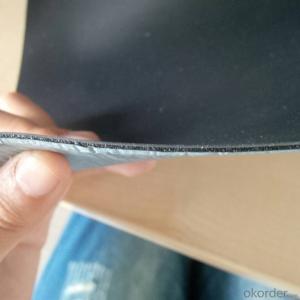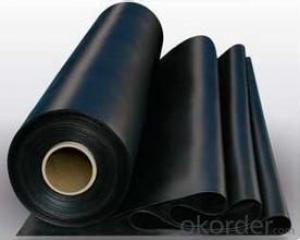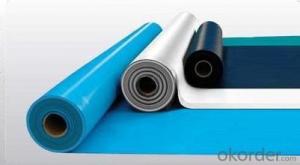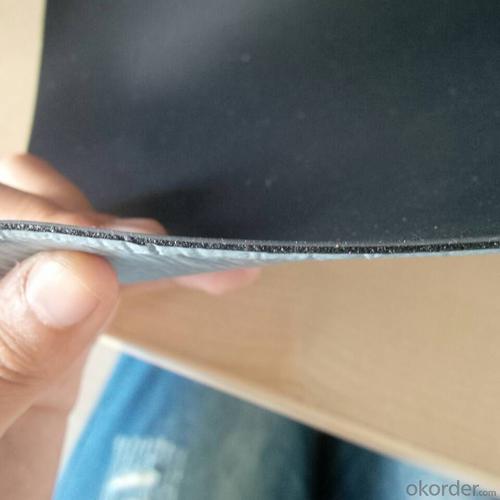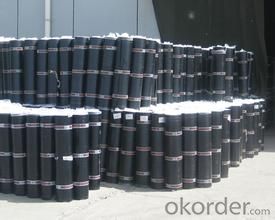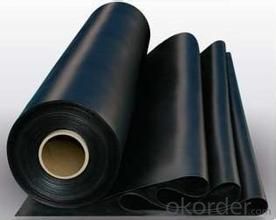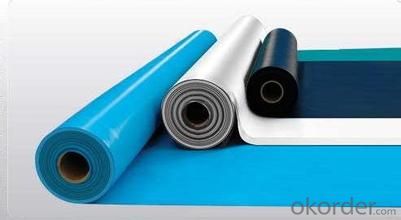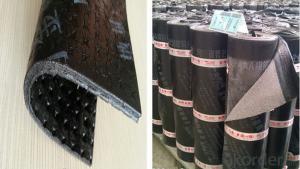SBS Modified Waterproof Membrance
- Loading Port:
- Tianjin
- Payment Terms:
- TT or LC
- Min Order Qty:
- 10000 m²
- Supply Capability:
- 15000000 m²/month
OKorder Service Pledge
OKorder Financial Service
You Might Also Like
Quick Details
Type: | Waterproof Membrane, Waterproof membrane | Place of Origin: | China (Mainland) | Brand Name: | CMAX |
Model Number: | ASTM | Model number: | SBS | Usage: | subway cold storage airport runway and viaduct |
Thickness: | 2-5mm | Heat Resistance: | 105 degree | Surface: | PE,S,M |
Weight: | 31.5-50kg/roll | Solubles: | 2900 g/square meter | Standard: | GB18242-2000 |
Tensile Strength: | 450N/50mm |
Packaging & Delivery
Packaging Details: | packed in rolls with pallets |
Delivery Detail: | within 10 days after receipt downpayment |
Product Characteristics
Good capacity of anti-aging, anti-acid, and anti-alkali, its service life is 30years.
High tensile strength and elongation which adapts to the contraction or crack of the base.
Good perdurable capacity to climate; be used in cold(-25°C)environment for long life.
Applied by torch.
Widely applied in roofing, basement, pool, subway etc.
Construction Requirements Basement Treatment
The waterproofing base should be strong smooth, and clean without particles on the surface. No peeling or cracking shall exist on the surface. The corners of the base shall be made into arcs with a radius of no less than 20mm or triangular. The drain slope, division seam, and air vent shall be carried out and treated according to design requirements. Then brush promer on the foundation until it is dry.
Installation
Place the sheet correctly, fire torch, evenly heat the sheet and foundation ,When the surface of the sheet is black and bright with a fusion layer apply the sheet and press it into a solid and flat state. Before the sheet is cool, seal the edge of joints by float.
Cautions installation is forbidden during rain, snow, fog, strong wind.
The temperature should be 5-35°C during installation.
All nodes should be reinforced during installation.
Keep away from fire during storage.
Package transportation and storage
The product is packed by plastic bag or adhesive tape.
Thickness:2-4mm width:1.0mm length:7.5mm 10mm
During storage and transportation, keep the package well, put them in a dry ,airy place, keep away from direct sunlight, acids, alkalis, oil and organic solvents.
FAQ
1. Could you send free sample ?
Yes , free sample is available .
2. What's the MOQ ?
MOQ is 5000 M2 .
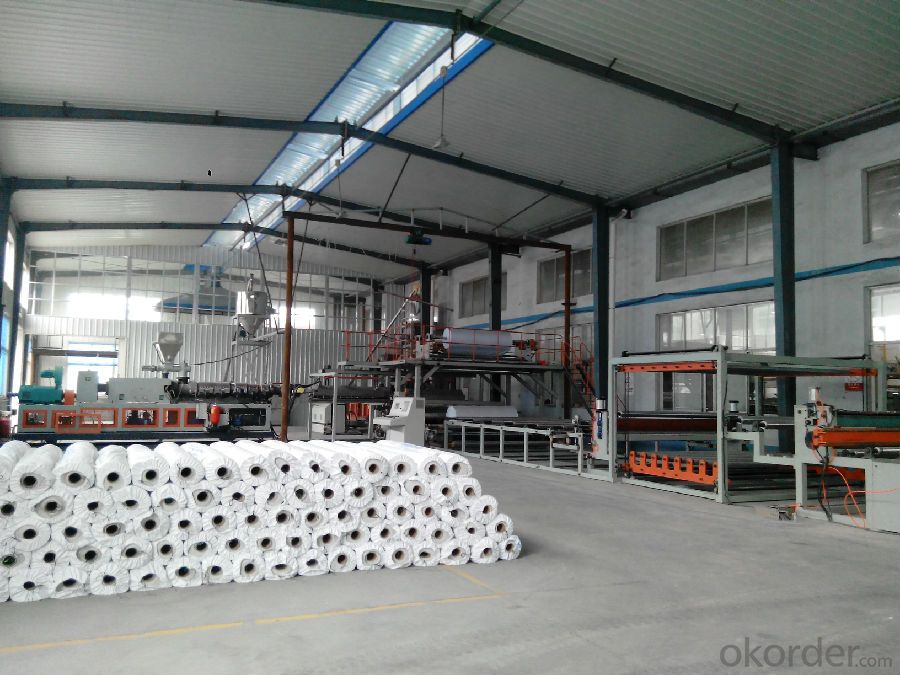
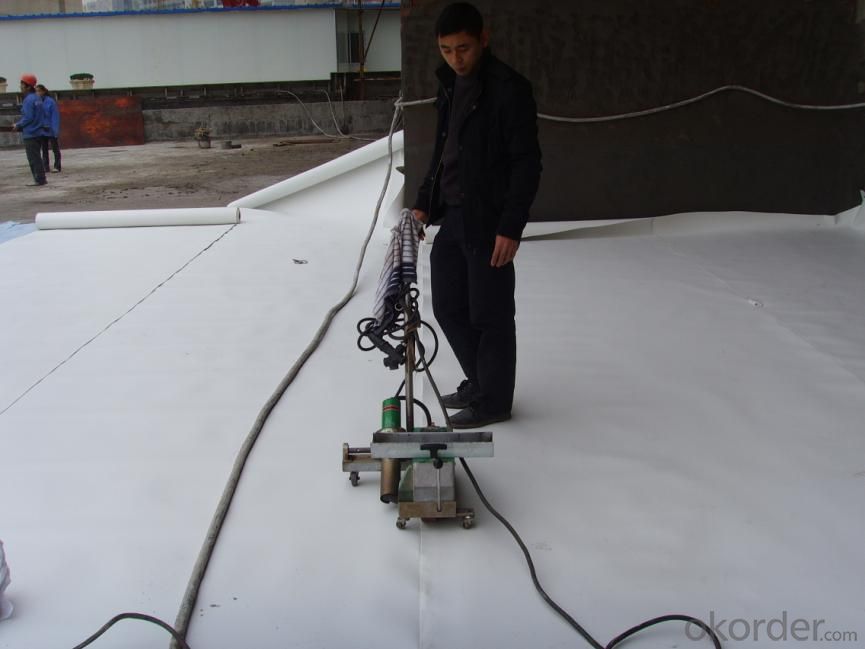
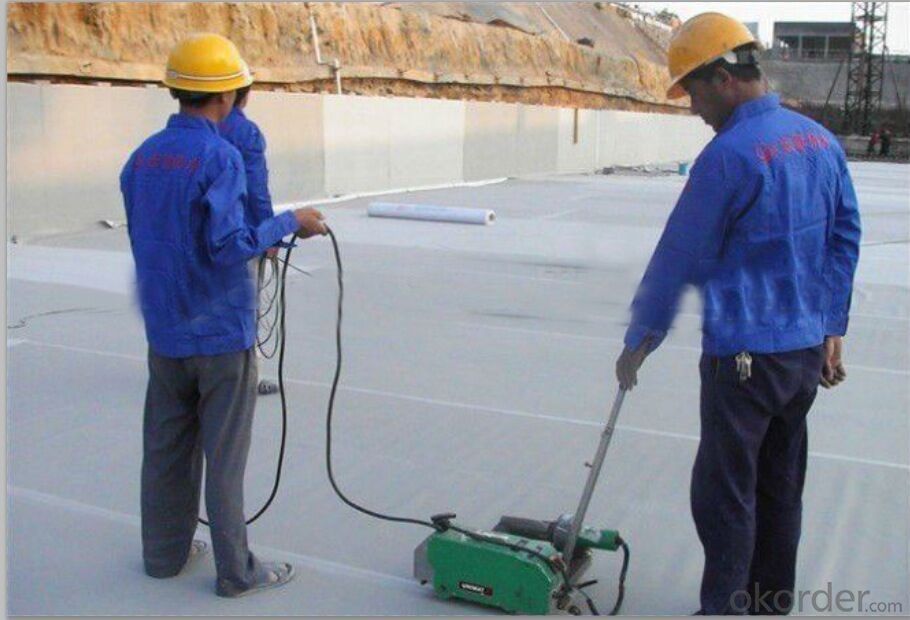
- Q: Does a waterproofing membrane require any specific surface preparation?
- Yes, a waterproofing membrane does require specific surface preparation before installation. The success and effectiveness of the membrane largely depend on the quality and condition of the surface it is applied to. Firstly, the surface needs to be clean and free from any dirt, debris, oil, grease, or loose particles. This can be achieved by thoroughly cleaning the surface using a pressure washer, scrub brush, or appropriate cleaning agents. Any existing coatings or sealants should also be removed to ensure proper adhesion of the membrane. Secondly, the surface should be smooth and even. Any uneven areas, cracks, or holes should be repaired and leveled before applying the membrane. This can be done by filling the cracks or holes with a suitable filler or patching compound and smoothing it out to create a uniform surface. Thirdly, the surface should be dry. Moisture can compromise the adhesion and effectiveness of the waterproofing membrane. Therefore, it is important to ensure that the surface is completely dry before starting the installation. This may require allowing the surface to air dry or using appropriate drying methods such as fans or dehumidifiers. In addition to these general surface preparations, specific types of waterproofing membranes may have additional requirements. For example, some membranes may require a primer to be applied on the surface before installation. It is essential to follow the manufacturer's instructions and recommendations for the specific membrane being used. Overall, proper surface preparation is crucial for the success of a waterproofing membrane installation. It ensures optimal adhesion, durability, and performance of the membrane, ultimately preventing water penetration and protecting the underlying structure.
- Q: Can a waterproofing membrane be used for a plaza deck waterproofing?
- Plaza deck waterproofing necessitates the use of a waterproofing membrane as they are consistently exposed to the elements, such as rain and snow. This is crucial in preventing water infiltration and potential harm to the underlying structure. Waterproofing membranes are specially designed to serve this purpose and safeguard the deck against moisture-related problems like leaks, deterioration, and mold formation. These membranes are typically constructed from materials like bitumen, PVC, or EPDM, and are applied in multiple layers to guarantee a strong and impermeable seal. By utilizing a waterproofing membrane, plaza decks can effectively preserve their structural integrity and longevity.
- Q: Can a waterproofing membrane be used for sealing pipe penetrations?
- Yes, a waterproofing membrane can be used for sealing pipe penetrations. Waterproofing membranes are specially designed to create a barrier against water intrusion and can effectively seal various types of penetrations, including pipes. They are commonly used in construction projects to prevent water leaks and damage. By applying the waterproofing membrane around the pipe penetration, it creates a watertight seal that prevents water from entering or escaping through the opening. This helps to maintain the integrity of the building envelope and protect against potential water-related issues, such as leaks, mold growth, and structural damage. Additionally, waterproofing membranes are often flexible, allowing them to adapt to the shape and size of the pipe penetration, ensuring a secure and durable seal.
- Q: Can waterproofing membranes be used on elevator shafts?
- Elevator shafts, particularly in regions with high humidity or underground setups, often face moisture concerns. This is where waterproofing membranes come into play. These membranes, specifically designed to shield against water and moisture, avert any potential damage to the structural components or electrical systems by preventing their infiltration into the elevator shaft. Typically, these membranes are applied to the walls and floors of the shaft, establishing an impermeable seal that maintains a dry interior. Furthermore, in addition to their waterproofing capabilities, these membranes also aid in inhibiting the growth of mold and mildew, ensuring a safe and healthy environment for both elevator passengers and maintenance personnel.
- Q: Can a waterproofing membrane be used for roofing?
- Yes, a waterproofing membrane can be used for roofing. In fact, it is a common choice for many roofing applications. Waterproofing membranes are designed to provide a protective barrier against water infiltration, which is essential for preventing leaks and water damage on roofs. These membranes are typically made of durable materials such as asphalt, synthetic rubber, or thermoplastic, which are resistant to water and can withstand harsh weather conditions. They are installed over the roof surface and provide a seamless, watertight layer that helps to keep the interior of the building dry and protected. Additionally, waterproofing membranes can be used on various types of roofs, including flat roofs, sloped roofs, and even green roofs. Overall, using a waterproofing membrane for roofing is an effective way to ensure long-lasting durability and protection against water damage.
- Q: Can a waterproofing membrane be used on concrete block surfaces?
- Yes, a waterproofing membrane can be used on concrete block surfaces. Waterproofing membranes are designed to provide a barrier against moisture and water penetration, and they are commonly used on concrete block surfaces to protect against water damage and leaks. These membranes are typically applied as a liquid or sheet material and adhere to the surface of the concrete blocks, creating a protective layer that prevents water from seeping through. The waterproofing membrane helps to extend the lifespan of the concrete blocks by reducing the risk of water damage, mold growth, and deterioration. It is important to choose a waterproofing membrane that is specifically designed for concrete block surfaces and follow the manufacturer's instructions for proper installation to ensure the best results.
- Q: Can a waterproofing membrane be used in food processing or pharmaceutical facilities?
- Food processing and pharmaceutical facilities can make use of a waterproofing membrane. These facilities often rely on waterproofing membranes to keep the surroundings dry and prevent water damage. By creating a barrier against moisture, these membranes ensure that leaks and water penetration are avoided. This becomes particularly crucial in environments where hygiene and cleanliness are of utmost importance, like food processing and pharmaceutical facilities. Furthermore, these waterproofing membranes can be applied to floors, walls, and ceilings, guaranteeing comprehensive protection. They are also commonly made from materials that resist chemicals and bacteria growth, making them even more suitable for use in sensitive environments. Ultimately, incorporating a waterproofing membrane in food processing or pharmaceutical facilities proves to be an effective method of maintaining a dry and safe environment for the production of high-quality products.
- Q: Can a waterproofing membrane be used for planter boxes or green roofs?
- Yes, a waterproofing membrane can be used for planter boxes or green roofs. In fact, it is highly recommended to use a waterproofing membrane in these cases to prevent water leakage and damage to the underlying structure. A waterproofing membrane acts as a protective barrier, preventing water from seeping into the planter boxes or green roofs and causing potential issues such as rot, mold, or structural damage. By effectively sealing the area, a waterproofing membrane ensures that the water is contained within the intended space, promoting healthy plant growth and preserving the integrity of the structure.
- Q: Are waterproofing membranes resistant to rodent and insect infestation?
- Waterproofing membranes are generally not specifically designed to be resistant to rodent and insect infestation. While they are primarily used to protect structures from water damage, they may provide some level of barrier against pests. However, if rodents or insects are determined to infest a particular area, they can find ways to bypass or damage the membrane. To effectively prevent rodent and insect infestation, it is recommended to take additional measures such as sealing any gaps or cracks in the building, using appropriate pest control methods, and maintaining good hygiene practices. This will help ensure a more comprehensive approach to keeping pests out and protecting the integrity of the structure.
- Q: Can a waterproofing membrane be used in roofs?
- Roofs can indeed benefit from the use of a waterproofing membrane. It's a widely employed technique for safeguarding roofs against water-related harm. Typically composed of robust materials like rubber or modified bitumen, this membrane is applied to the roof's surface to establish a barrier that prevents water from seeping through. As a result, leaks and potential damage are averted, as this protective layer stops water from penetrating the roof's underlying structure. Waterproofing membranes are particularly advantageous for flat or low-sloped roofs, where water accumulation is prone to causing issues. Moreover, these versatile membranes can be utilized on diverse roofing materials, including concrete, metal, and asphalt, making them suitable for various roof types. Overall, incorporating a waterproofing membrane into roofs effectively enhances their durability and longevity, while ensuring dependable protection against water infiltration.
Send your message to us
SBS Modified Waterproof Membrance
- Loading Port:
- Tianjin
- Payment Terms:
- TT or LC
- Min Order Qty:
- 10000 m²
- Supply Capability:
- 15000000 m²/month
OKorder Service Pledge
OKorder Financial Service
Similar products
Hot products
Hot Searches
Related keywords
